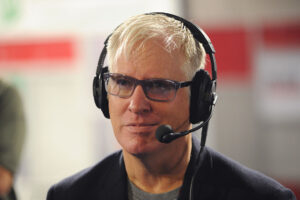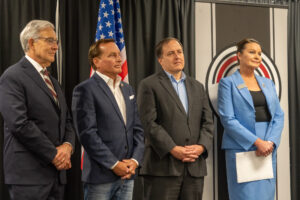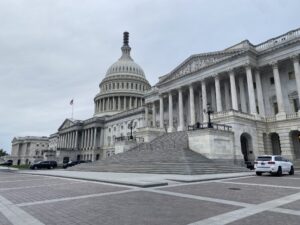5:55
News Story
As COVID spreads in Missouri, Parson and Galloway differ starkly on state’s response
Two weeks before voting begins, coronavirus weighs heavily on outcome of race
September was Missouri’s deadliest month since the coronavirus outbreak began, and there have been more than 400 deaths reported since the beginning of October.
Missouri’s veterans homes saw 56 residents die in just September and early October.
Daily hospitalizations routinely reach record highs, with Cox Health in Southwest Missouri last week reporting that it was treating over 100 COVID-19 patients in a single day, while Kansas City hospitals refused ambulances because their beds were already filled.
And while spikes in positive cases were previously associated with the state’s urban centers, the virus has moved into rural Missouri where cases are rising.
Missouri Gov. Mike Parson, a Republican, announced the state’s first confirmed case of COVID-19 on March 7. In two weeks, his handling of the pandemic will assuredly be a key factor in whether voters decide he should remain in office another four years.
His Democratic opponent Nicole Galloway has criticized his handling of the coronavirus outbreak, highlighting how it’s exacerbated already existing disparities in healthcare and calling for “a complete reset” on the state’s response.
Parson has fiercely defended his administration’s “balanced approach,” arguing his efforts helped stave off deeper economic pain. He has largely foregone statewide action and instead left most decisions up to local governments.

In interviews with The Independent, public health experts and epidemiologists say Parson’s patchwork response has left the state with an incomplete picture of the virus’ true spread.
But even Galloway’s alternative proposals may not be enough to curb the virus, public health experts warned, stressing the need for more statewide restrictions.
“When you have the power the governor has, I think the job is to solve problems — not to just let them grow and sort of nurse them along at a constant level,” said Benjamin Neuman, the head of Texas A&M University-Texarkana’s biology department and a virologist who has worked with coronaviruses for over two decades. “We’ve been more focused on keeping hospitals partly full — but not completely full — of COVID patients. And there really hasn’t been anywhere in the U.S. where there is a very strong push to actually get rid of this virus.”
Statewide restrictions
Parson has encouraged the use of face masks, though he often has appeared in public without one. Yet he’s rebuffed calls for a statewide mask mandate. Instead, he stresses the need for personal responsibility, and has pointed out that most of Missouri’s largest metros have local mandates. However, many of the state’s high-risk counties do not.

At a briefing last week, Parson brushed off questions as to whether he would ever require certain areas of the state to enforce masks. He likened it to requiring all residents to take a COVID-19 vaccine.
“Do we really want the governor of the state of Missouri to make a mandate that every man, woman and child be vaccinated?” Parson said. “That’s the powers you have in this office. … I won’t do that as governor.”
Experts say a statewide mask mandate is a simple, but effective, public health measure that is needed.
“It is never too late to start trying to fight against this virus. And that is exactly what a mask mandate would do,” Neuman said, likening mask use to the safety practice of wearing seatbelts.
In August, Dr. Deborah Birx, the coordinator for the White House Coronavirus Task Force, recommended Parson issue a mask mandate modeled after Texas’ — requiring masks in counties with 20 or more cases.
The Missouri State Medical Association and Missouri Nurses Association joined forces to urge Parson to implement a statewide mask mandate in July. Heidi Lucas, the state director for the Missouri Nurses Association, said that three months after her organization wrote a letter in support of a mandate, it is still the group’s No. 1 request.
Galloway has vowed to issue a statewide mask mandate.
But even with a mask mandate, it may still come down to personal responsibility in order to get people to comply, said Amesh Adalja, a senior scholar at the Johns Hopkins Center for Health Security and an infectious disease, critical care and emergency medicine physician. That means leaders need to convince people of the evidence that masks work.
On a call with reporters last week, Galloway cited a study by the Centers for Disease Control and Prevention that found after Arizona Gov. Doug Ducey allowed local mask mandates – which affected roughly 85 percent of the state’s population – cases declined by about 75 percent.
Galloway said a statewide mask mandate would empower local health departments to address issues of mask use, and regardless, she believes most Missourians would abide by one.
“Polling shows, data shows, that the majority of Missourians do want a statewide mask mandate because they see it as a ticket to freedom,” Galloway told reporters last week. “They see it as a way to get their lives back to normal.”
Reintroducing phases
Parson declared Missouri “fully open for business” in mid-June as he let the state’s social distancing order, which included limits on large gatherings and capacity for some businesses, expire.
Experts say Missouri needs to limit opportunities for the virus to spread, like large gatherings and indoor dining.

Phased reopenings allow officials to dial things back to ensure acute peaks don’t turn into a broader surge, said Karen Joynt Maddox, a cardiologist and co-director of the Center for Health Economics and Policy at Washington University in St. Louis’ Institute for Public Health.
“The virus doesn’t care what phase it’s in. It just cares how many people it can make contact with,” Joynt Maddox said.
Galloway’s COVID-19 plan does not address reintroducing statewide limits on gatherings or businesses. In a statement last week, Eric Slusher, a spokesman for Galloway’s campaign, said Galloway’s plan aims “to prevent another round of shutdowns.”
The same things that were necessary at the start of the pandemic — widespread testing and contact tracing to identify and contain positive cases — are still needed now. But they’ll be even more difficult to implement, said Michael Buchmeier, a University of California, Irvine professor of medicine and biological sciences and associate director of its Center for Virus Research.
“It’s not going to be as easy as it would have been, but it’s still not impossible,” Buchmeier said. “And you can certainly slow it down.”
YOU MAKE OUR WORK POSSIBLE.
Missouri is considered “far below” its target of COVID tests needed to mitigate the virus, based on a methodology developed by researchers at the Harvard Global Health Institute. As of Tuesday, Missouri was only reaching 45% of its testing target, according to The New York Times.
Relative to other states, Missouri ranks in the bottom third in testing. Some states report the number of people tested and some states report the total number of tests performed. Missouri does both.
Of the 27 states that report the number of people tested, Missouri ranks 17th in per capita testing, according to data from the COVID Tracking Project. Of the 44 that report the number of tests performed, Missouri is 28th.
Galloway’s plan proposes entering into a compact with surrounding states to “combine purchasing power” and acquire more rapid tests — a step that could boost Missouri’s testing capacity, Adalja said.
“If you’re a state that opens without that type of infrastructure, your case contact investigators are going to get underwater really quickly and you’re going to have chains of transmission that land on vulnerable populations that will end up in the hospital,” Adalja said. “And then your hospitals will start to feel the pressure.”
Overwhelmed hospitals, rural areas
And in Missouri they already are. Last week, hospitalizations hit 1,465 COVID-19 patients — a record for the state. Outside of the St. Louis and Kansas City metro areas, hospitalizations are rising in Southwest Missouri, according to the state’s dashboard.
Lucas, the state director for the Missouri Nurses Association, said there are nurses who still lack the necessary protective equipment and have to reuse masks. Some have been told that if they contract COVID, they’ll have to use their own time off to stay away from work for two weeks. Others are leaving the profession altogether.
“It’s a terrible, terrible disease and it’s a terrible way to die. And our nurses that are working with them every day have really had to come to grips with that,” Lucas said. “And it is taking a toll.”
Missouri’s seven-day average positivity rate was at 21.1 percent on Tuesday — roughly four times the national average of 5.3 percent.
Last week, the positivity rate increased most rapidly in rural counties — with eight counties reporting seven-day positivity rates over 50 percent for the week ending Oct. 14, according to the state’s dashboard.
“I don’t know that it’s any surprise to anyone that this is happening in rural Missouri right now,” Parson said at a briefing last week.
A positivity rate so high in the double digits is “a frightening number,” Joynt Maddox said.
Officials need to intensely focus on rural areas of the state, bolstering access to testing and contact tracing to quickly curb the spread, experts said.
“The problem is when the virus gets into a rural area, it is much harder to get it out. There isn’t as much testing. It is farther to drive for a hospital,” Neuman said.
Better data
To understand where the virus is spreading requires accurate data.
The Department of Health and Senior Services credited a “database extract error” for 5,020 cases that were mistakenly added on Oct. 10. The error appeared to show a record influx of cases being reported in 24 hours, when it “actually reflected an increase over the previous two weeks,” Parson said last week.
Parson stressed the data wasn’t lost. Kelli Jones, the governor’s spokeswoman, said in a statement last week that DHSS “took immediate action to address it to ensure our data remains accurate and reliable.”
GET THE MORNING HEADLINES.
It’s not the first time the state’s dashboard has had errors. When asked the level of trust Missourians should put in the state’s dashboard in light of repeated data issues, DHSS Director Randall Williams said last week: “I would say high.”
Galloway’s plan calls for a task force of medical professionals, epidemiologists and other experts to act as a hub for collecting COVID data, emphasizing the need to not rely on the CDC for hospitalization figures.
On Monday, DHSS made data on COVID tests, cases and deaths available to download for the first time since transitioning to its new dashboard that was unveiled in late September.
Going into the pandemic, Missouri didn’t have the infrastructure it needed to consistently track data over time, putting the state at a disadvantage, Joynt Maddox said, noting there are gaps in racial data.
“The changes in the data reporting and the data structure and data lag — and all those things this late in the pandemic — really speaks to the fact that we were unprepared,” Joynt Maddox said.
To prepare Missouri for the future, pandemic response will need to be a priority, Adalja said.
“There’s no way that we fix our pandemic preparedness,” Adalja said, “unless politicians are judged on their ability to handle this crisis.”
Our stories may be republished online or in print under Creative Commons license CC BY-NC-ND 4.0. We ask that you edit only for style or to shorten, provide proper attribution and link to our website. AP and Getty images may not be republished. Please see our republishing guidelines for use of any other photos and graphics.





